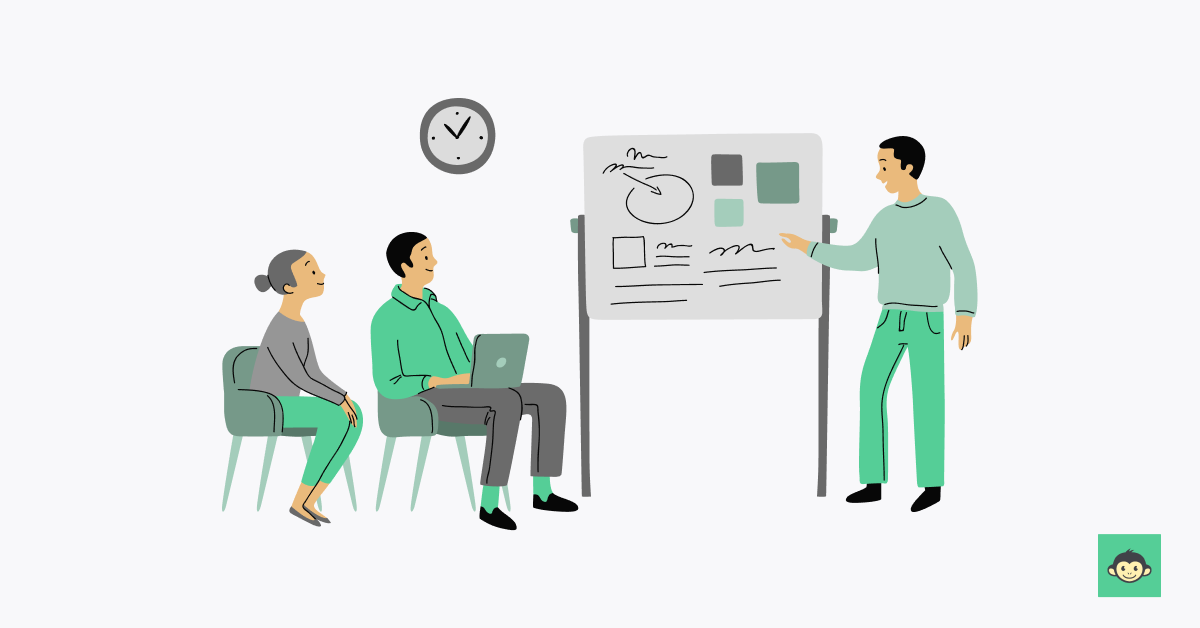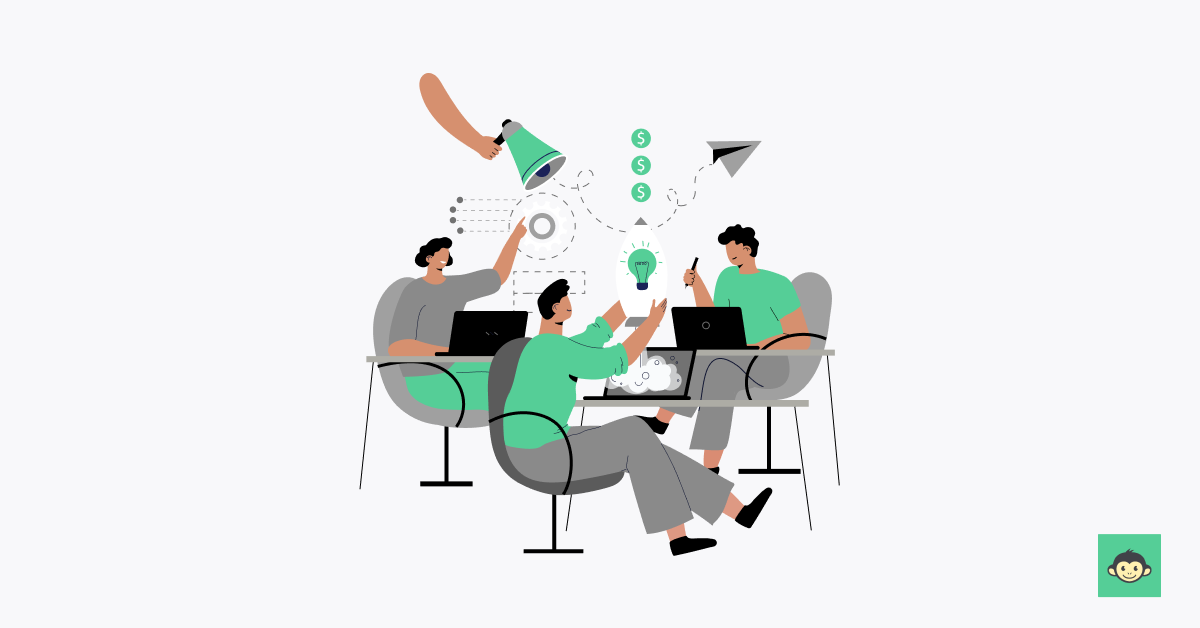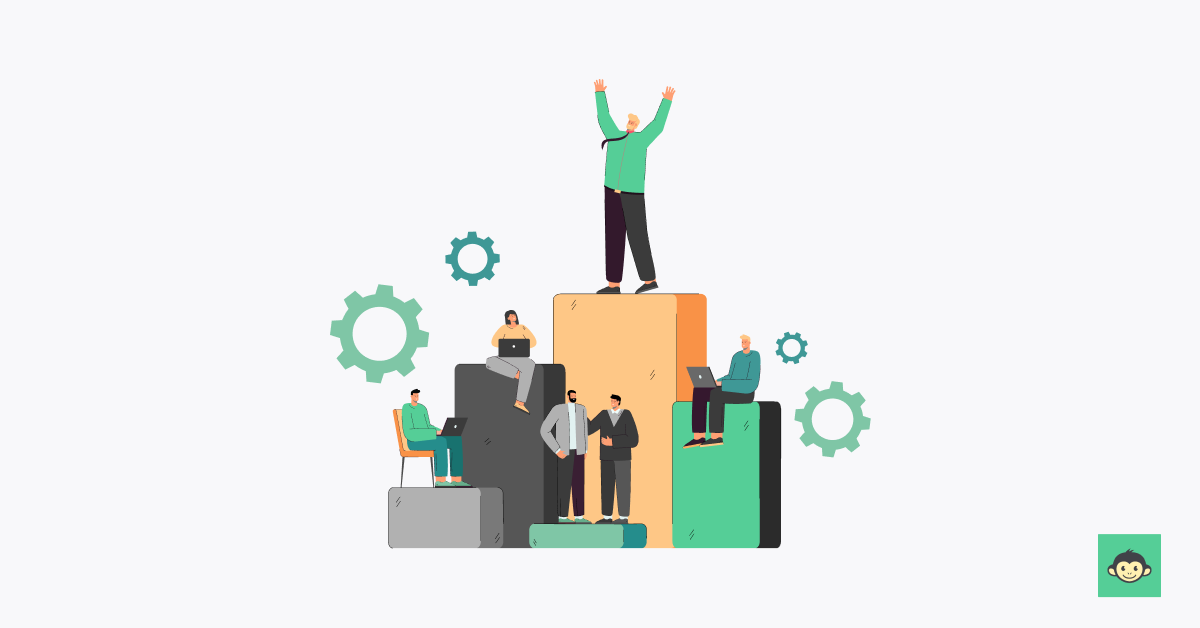What is employee crossboarding: Definition, best practices, and top strategies to try in 2024

Forget the red carpet for external hires – in today's market, employee cross-boarding is emerging as a game-changer. Gone are the days of relying solely on hiring new faces to fill vacant roles.
Cross-boarding recognizes the immense potential within your existing workforce, focusing on promoting from within, developing internal talent, and providing the training needed to fill new roles or departments.
This blog dives deep into the exciting world of crossboarding, equipping you with the knowledge and strategies to implement it effectively in 2024. Buckle up, as we explore what exactly crossboarding is, and why you should care.
Crossboarding definition
Crossboarding is the strategic process of seamlessly integrating existing workers into new roles, teams, or departments within an organization.
Unlike traditional onboarding, which typically focuses on orienting new hires, crossboarding specifically addresses the transition of current workers to different positions, thereby optimizing talent utilization and fostering internal mobility.
This approach emphasizes a holistic approach to an existing employee's development and engagement, ensuring that individuals remain aligned with the company's evolving needs.
In essence, crossboarding is about empowering workers to take on new responsibilities, acquire additional skills, and contribute to the organization's success in different capacities.
It involves facilitating a smooth transition for the chosen employee or team members as they move across departments, teams, or roles, thereby maximizing their potential and enhancing their overall satisfaction.
Why does crossboarding matter?
Cross boarding matters because it optimizes talent within the organization by strategically transitioning existing workers into new roles, teams, or departments.
This process fosters internal mobility, enabling workers to develop skills, take on additional responsibilities, and contribute more effectively to the company's evolving needs.
Moving your workers internally serves as a proactive solution to evolving workforce dynamics, ensuring that organizations can adapt quickly to changing demands.
It fosters a culture of continuous learning and development, allowing workers to stay motivated and engaged by offering new challenges and growth opportunities.
What is the difference between crossboarding and onboarding?

Onboarding and cross boarding play pivotal roles in shaping the work experience. While both contribute to organizational success, they are distinctly focused on different phases of an employee's journey.
Let's delve into the nuances of each process, exploring their unique purposes, timelines, and impacts on individual development and organizational effectiveness.
Onboarding:
- Definition: The onboarding process refers to the comprehensive procedure of integrating and orienting new members into a company, typically during their initial days or weeks.
- Focus: The primary focus of onboarding is to help a new hire assimilate into the company culture, understand their roles and responsibilities, and acquire the necessary knowledge and skills for their specific positions.
- Timing: Onboarding typically occurs when individuals are newly hired. These new hires are onboarded to ensure a smooth transition for them into the vacant position or roles within the organization.
Cross boarding:
- Definition: Cross boarding is the process of doing new jobs or transitioning existing employees into new roles, teams, or departments within the same company.
- Focus: The central focus and many advantages of cross boarding is on the internal mobility of current workers, allowing them to take on new responsibilities, develop additional skills, and contribute to the business in different capacities.
- Timing: Cross-boarding can happen at various points in an employee's tenure, not necessarily during their initial days with the business. It comes into play when workers are moving within the business and take on new challenges or roles.
What is a cross-boarding process?

The cross-boarding procedure is a strategic and systematic approach employed by organizations to facilitate the smooth transition of existing workers into new positions, teams, or departments within the same company.
Unlike traditional onboarding processes, which are designed for new hires, cross-boarding specifically addresses the unique needs and challenges associated with internal mobility.
Key components:
- Identification of opportunities: The procedure begins with identifying opportunities for internal mobility. This may involve assessing the skills, interests, and career goals of current workers and matching them with a vacant position or upcoming positions within the company.
- Communication and transparency: Transparent communication is crucial. Organizations should clearly communicate the available opportunities, the expertise required, and the potential advantages to workers, fostering a culture of openness and trust.
- Skill assessment and training: To ensure a successful transition, organizations may assess the existing skills of workers and provide targeted training or development programs to bridge any gaps. This could include acquiring knowledge, or certifications relevant to the new role.
- Supportive resources: Providing the chosen individual with resources and support, such as mentorship programs, and a cross boarding buddy, and access to relevant information and materials, helps them navigate the employee transition much more effectively
- Integration planning: Just like onboarding for new hires, a well-structured integration plan is essential for the existing employees or workers. This plan may include a detailed orientation to the new employee and role, team introductions, and information about the new department's goals and expectations.
Advantages of internal transfers
Organizations are increasingly recognizing the strategic value of moving your existing employees internally.
By seamlessly transitioning existing workers into new positions, this approach not only optimizes talent but also brings forth a myriad of advantages that positively impact engagement, organizational culture, and talent development.
- Optimized talent utilization: This activity maximizes the utilization of existing talent within the business, aligning individuals with roles that best leverage their skills and expertise. This optimization ensures that each individual also contributes effectively to the company's goals, promoting efficiency and productivity.
- Cost-effective talent development: Moving your workers internally proves to be a cost-effective approach to talent development. By investing in the growth of current workers, organizations reduce the reliance on external hires and associated recruitment costs. This internal focus on development aligns with strategic budget considerations.
- Improved employee retention: Providing growth opportunities and recognizing the potential within the existing workforce and hiring them contributes to improved retention. Satisfied and engaged employees are more likely to stay with the company, reducing turnover rates.
- Dynamic corporate culture: Moving your workers internally contributes to a dynamic corporate culture characterized by adaptability and continuous learning. Embracing internal mobility as a cultural norm encourages workers to embrace change positively and stay attuned to industry trends.
Cross board checklists to keep in mind in 2024

While navigating the evolving landscape of workforce dynamics in 2024, effective processes are essential for organizations aiming to optimize their existing talent.
This checklist provides a comprehensive guide, incorporating key considerations to ensure a seamless and successful experience, fostering growth and organizational adaptability.
Talent assessment and alignment:
- Conduct a thorough evaluation of existing workers' skills, aspirations, and career goals.
- Align identified talent with organizational needs and potential cross-team opportunities.
Transparent communication:
- Communicate opportunities transparently, outlining roles, expectations, and business.
- Foster open dialogue between workers and management to address queries and concerns.
Continuous skill development:
- Identify skill gaps through assessments and provide targeted training programs.
- Ensure ongoing skill development to equip employees for their new roles and responsibilities.
Materials and support:
- Establish a support system, including cross-team mentors or buddies.
- Provide access to materials, and support networks to ease the transition.
Integration planning:
- Develop a detailed integration plan, encompassing orientation, team introductions, and goal-setting.
- Ensure a seamless assimilation into the new role, fostering a positive experience for workers.
Regular feedback loop:
- Implement regular check-ins to gather feedback on the procedure.
- Use feedback to make necessary adjustments, address challenges, and enhance the experience.
Recognition and celebration:
- Recognize and celebrate successful cross-boardings as part of organizational culture.
- Highlight achievements to motivate employees and reinforce the value of internal mobility.
Success metrics and evaluation:
- Define key performance indicators (KPIs) to measure the success of cross-team.
- Regularly evaluate the impact on organizational goals and adjust strategies accordingly.
Legal and compliance check:
- Ensure compliance with employment laws and regulations during the procedure.
- Conduct legal checks related to employee transitions and ensure they create a handover document appropriately for their replacement.
Continuous improvement strategy:
- Implement a continuous improvement strategy for the procedure.
- Learn from each cross-team experience to refine processes and enhance future initiatives.
Common challenges encountered when crossboarding existing employees

As organizations increasingly embrace internal mobility, several common hurdles emerge in the internal transfer procedure, ranging from skill gaps and communication issues to potential resistance from employees.
Addressing these challenges head-on is crucial to ensure a smooth and successful transition, for all involved.
- Skill gaps: Identifying skills gaps, and bridging skill gaps between existing competencies and those required for the new role can pose a significant challenge.
- Communication breakdowns: Inadequate or unclear communication about the internal transition opportunities, expectations, and changes may lead to misunderstandings and resistance.
- Integration issues: Ensuring seamless integration into the new team or a new department, may present challenges, affecting an employee's sense of belonging and productivity. Lack of adequate support systems, including mentorship programs may add to the employees feeling isolated.
- Resource allocation: Inadequate allocation of materials, including time and training materials, can hinder the effectiveness of the procedure.
- Lack of metrics for success: Without clear metrics to measure the success of these moving initiatives, organizations may struggle to assess their effectiveness and make necessary improvements.
- Resistance of cross boarded employees from existing team members: Existing team members may resist the integration of cross boarded employee across-boarded employees, affecting team dynamics and collaboration.
- Managerial challenges: Managers may face challenges in effectively leading cross boarded teams, including balancing workload distribution and fostering team cohesion.
Understanding and proactively addressing these challenges is essential for organizations seeking to optimize their internal moves and unlock the full potential of their internal talent pool.
Top 5 strategies to ensure smoother internal transfer for an existing employee to a new team
This move is likely to come with some new difficulties. Someone making a lateral move, for example, will have a fresh team and new ways of working that they will need help getting to grips with. Here are some strategies to help the process -
1. Comprehensive communication plan:
- Develop a clear and transparent communication plan outlining cross-team opportunities, expectations, and advantages for workers.
- Establish regular channels for feedback and address concerns promptly to foster a culture of open communication.
2. Tailored training and development:
- Conduct thorough assessments of existing workers' skills and identify specific training needs for the targeted roles.
- Implement customized training programs to bridge skill gaps and prepare staff for the challenges of their new positions.
3. Robust integration processes:
- Provide cross-boarded staff with materials, support networks, and mentorship programs to enhance their sense of belonging and productivity.
- Help make your mover feel more comfortable within their cross boarded team with frequent check-ins.
4. Continuous feedback mechanism:
- Implement a structured feedback loop, including regular check-ins and performance evaluations, to monitor the progress of cross-boarded staff.
- Use feedback to make necessary adjustments, address challenges promptly, and provide ongoing support for successful integration.
5. Cultivate a culture of internal mobility:
- Foster a culture that values and promotes internal mobility as a strategic talent management approach.
- Highlight success stories of cross-boarded staff, emphasizing the advantages of internal growth and development to inspire others within the business.
How can an employee experience platform help you ensure smooth cross boarding at work?
An Employee Experience Platform (EXP) can significantly contribute to ensuring smoother processes at work by providing a centralized, integrated solution that addresses various aspects of the process. Here's how an EXP can be instrumental:
- Centralized information hub: An EXP serves as a central repository for all employee-related information, consolidating details such as available opportunities, training materials, and integration plans.
- Performance monitoring and feedback: EXP platforms enable continuous performance monitoring through features like performance dashboards and analytics. Managers can provide real-time feedback, and staff can access performance metrics, fostering a proactive approach to addressing challenges and ensuring ongoing improvement.
- Recognition and rewards: EXP platforms often include features that highlight the achievements of cross-boarded staff. Recognition and rewards within the platform contribute to the overall satisfaction and motivation of staff undergoing the process, fostering a positive organizational culture.
- Employee engagement surveys: EXP platforms may include tools for conducting engagement surveys, gathering valuable insights into the experience. Feedback obtained through surveys helps organizations refine and improve their internal transfer strategies based on individual input, promoting continuous enhancement.
- Integration with HR systems: Seamless integration with existing HR systems ensures that individual data, performance metrics, and other relevant information are consistently updated. This integration streamlines administrative processes and contributes to a holistic view of employees' journeys within the company.
5 Crossboarding examples to get to know it better

Let's explore five real-life examples of internal transfer, where companies help their employees learn new things, grow in their careers, and bring fresh ideas to their teams.
These stories show how cross boarding can make work more exciting and help people try different jobs within the same office.
- Internal transfer for skill expansion: A marketing specialist with strong analytical skills expresses interest in data analysis. Through cross boarding, the individual transitions to a role within the data analytics team, acquiring new skills and contributing to the organization's data-driven initiatives.
- Vertical movement for career progression: An experienced customer service representative desires career growth. Through an internal transfer initiative, the individual moves vertically to a supervisory role, leveraging their expertise to enhance team performance peak productivity and customer satisfaction.
- Interdepartmental rotation for versatility: An IT professional interested in broadening their skill set participates in an interdepartmental internal transfer program. They rotate through roles in cybersecurity, systems administration, and software development, gaining versatility and a holistic understanding of the IT landscape.
- For leadership development: A high-performing project manager is identified as a potential leader. Through an internal transfer strategy, the employee or new manager is transitioned to a leadership development program, acquiring managerial skills and experiences to prepare for future leadership roles.
- Skill-driven internal transfers for innovation: An organization recognizes a growing need for employees with expertise in artificial intelligence. Through a skill-driven internal transfer initiative, employees from various departments are trained in AI, fostering innovation and ensuring the org stays at the forefront of technological advancements.
Conclusion
From empowering employees to fostering a dynamic organizational culture, the advantages of internal transfers are substantial. Through transparent communication, tailored training, and a commitment to continuous improvement, companies can overcome challenges and ensure a seamless cross-boarding experience to empower employees.
Ready to enhance your organization's cross-boarding experience? Explore the power of employee engagement with CultureMonkey!



